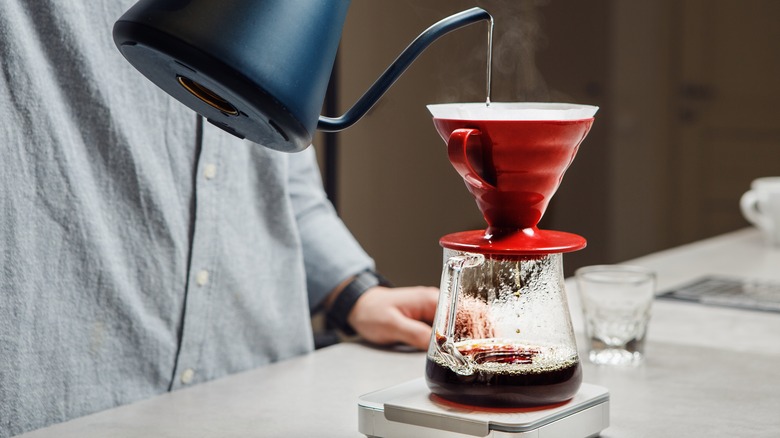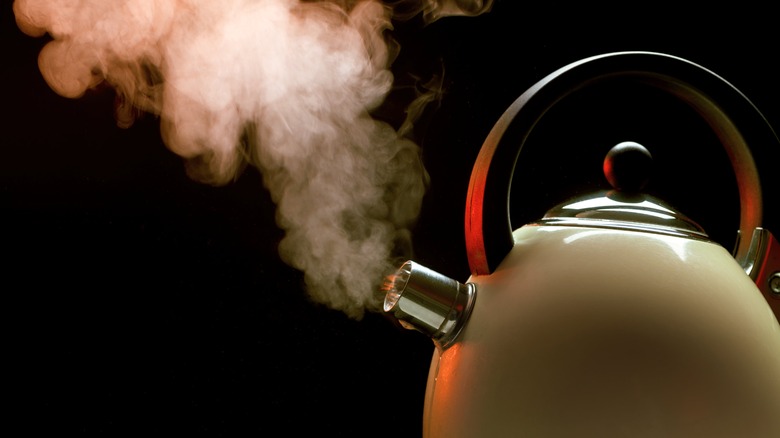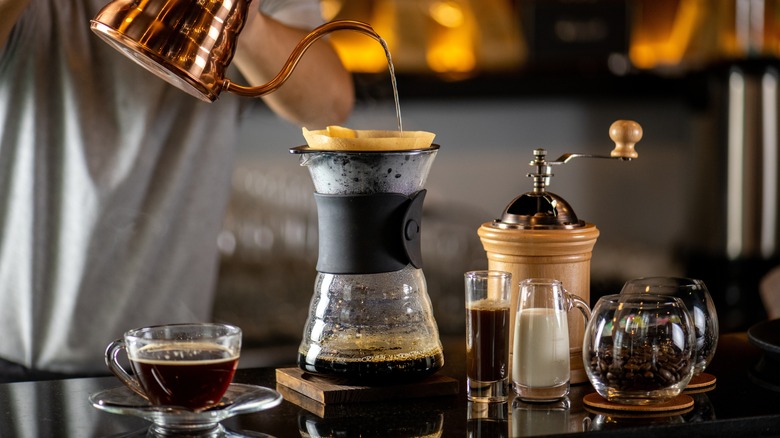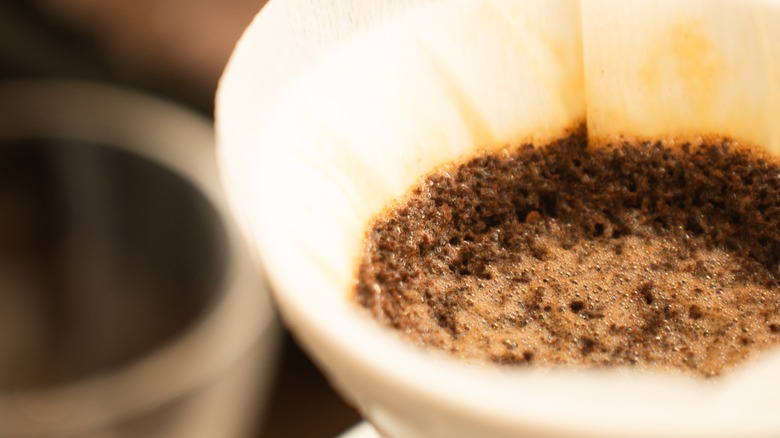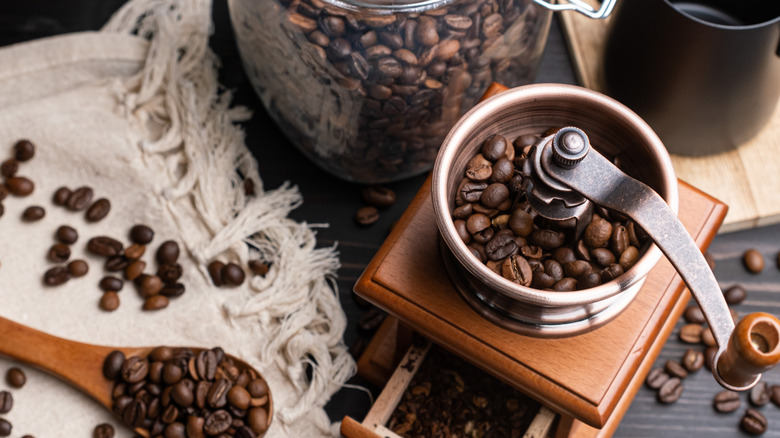Avoid These Mistakes If You Want Perfect Pour Over Coffee Every Time
We may receive a commission on purchases made from links.
If you're new to drinking coffee or don't care to bother with much prep work, you may be perfectly happy with instant coffee (which can taste amazing if you avoid these mistakes). If you're ready to move up the coffee food chain, though, now is the time to choose the right coffee maker for your needs. With that in mind, if you ever get to the point where coffee is the most significant part of your diet, you might be ready to learn how to make coffee using the pour-over method. According to Heather Perry, CEO of Klatch Coffee, it's quite an ongoing process.
"We think it's important to keep a log or diary of your efforts," Perry advised. That way, you'll have a record of all of the different variables; among them grind, temperature, and the water-to-coffee ratio. "When you really nail a pour-over," says Perry. "You want to have a record of the inputs so you can keep it consistent in the future, if desired, or be deliberate about planned changes." If you aren't happy with how your pour-over coffee is turning out, you'll want to consider these common mistakes.
Overheating the water
If you're using a standard tea kettle to heat the water for your pour-over, you may be botching things right from the get-go. At sea level, water boils at 212 degrees Fahrenheit. Heather Perry advocates that pour-over coffee is best made with water between 195 and 205 degrees Fahrenheit. Assuming you have a dedicated pour-over kettle complete with a temperature control mechanism, she recommends setting it at 200 degrees.
What can you do if you don't have a temperature-controlled kettle, though? Do you need to give up your pour-over efforts until you can purchase one? No, that won't be necessary. "If you don't have access to precise temperature control, you can bring the water just to a boil," she told The Takeout. "Then remove it from the heat and wait 30 seconds." You could also pour boiling water into a mug, then check it with a kitchen thermometer and add cold water until it reaches the desired temperature.
Failing to rinse the filter
Some pour-over filters are made of metal or plastic, but many devices take a paper filter. The idea of pre-rinsing paper filters might seem a bit strange. After all, why would you want your coffee to taste of soggy paper? According to Heather Perry, this isn't what happens. As she explains, "There are quite a few reasons we pre-rinse the filter before we pour in our ground coffee for a pour-over."
Instead of adding any wood pulp flavor to the coffee, Perry tells us that rinsing the filter actually "helps wash away the potential papery taste the filter may carry." She also notes that rinsing can wash away any dust or dirt or extraneous bits of paper from the packaging. Finally, she explains that using a wet paper filter can help create a seal between the grounds and the other components of the pour-over device, something she says makes for a more consistent cup of coffee.
Pouring too slowly or too quickly
If you want to use the proper pour-over jargon, Heather Perry says she and her fellow coffee professionals refer to the "three Ts" of pouring. The first two are temperature (which we've already dealt with) and time (meaning how long the grounds stay in contact with the water). Time will vary according to your preference, but Perry says three to five minutes is average. The third "T" stands for turbulence, which she defines as "the way the coffee grounds are moving in response to the water being poured in."
The key to a good pour is consistent speed. "Too slow of a pour may create channels in the grounds that are uneven, but too fast of a pour may disrupt the coffee bed and create channels that way, too." While you may need to experiment to find the speed that works for you, Perry's idea of the perfect pour involves "a steady, thin stream of water and a circular motion circling in and out for optimal consistency." If you manage to pull this off, she says, all of the coffee grounds should get an equal wetting.
Not waiting until the coffee's done blooming
Blooming means multiple things in the kitchen. When used as a noun, bloom can refer to the white stuff on chocolate or grapes (don't worry, it's not mold). As a verb, it can refer to the process of activating yeast or the technique of pre-heating spices in fat to make them more flavorful. In coffee terms, "Blooming is the release of carbon dioxide trapped in the beans, creating a bubbling effect."
While the coffee is blooming, the water might not be able to reach the grounds, and the trapped gas may block the extraction process. In order to circumvent this: "Add enough water to get the grounds wet and note how they foam and bubble. Then wait until the bubbling is done before you add more water." In Perry's experience, the proper amount of water necessary to start the bloom is about two to four tablespoons, while the bubbling should elapse in about 30 seconds.
Using the wrong grind or amount of coffee
In Heather Perry's opinion, medium grind coffee (the same kind usually used in automatic drip coffee makers) makes a good starting point for pour-overs. This way, you can always use it (and your machine) as a fall-back if your pour-over attempts don't succeed. Once you've got the hang of making pour-over coffee, though, Perry says you can branch out and experiment with different grinds. As she reminds us, "One of the best parts of pour-over coffee is the ability to make it your own because you control every last detail."
Perry does, however, advise that you check the instructions for your particular pour-over coffee maker, as different manufacturers may recommend different grinds. This also applies to the amount of coffee you use. "The water to coffee ratio can vary slightly based on your personal preferences, as well as the brewing device you're using." While some guides to making pour-over coffee recommend using 16 parts water to 1 part coffee, Perry notes that certain machines recommend using ratios as low as 13:1. As she put it, "You can tweak those instructions up or down if you prefer a stronger or weaker cup." After all, there's no point in going through so much effort if you're not making coffee that suits your taste.
